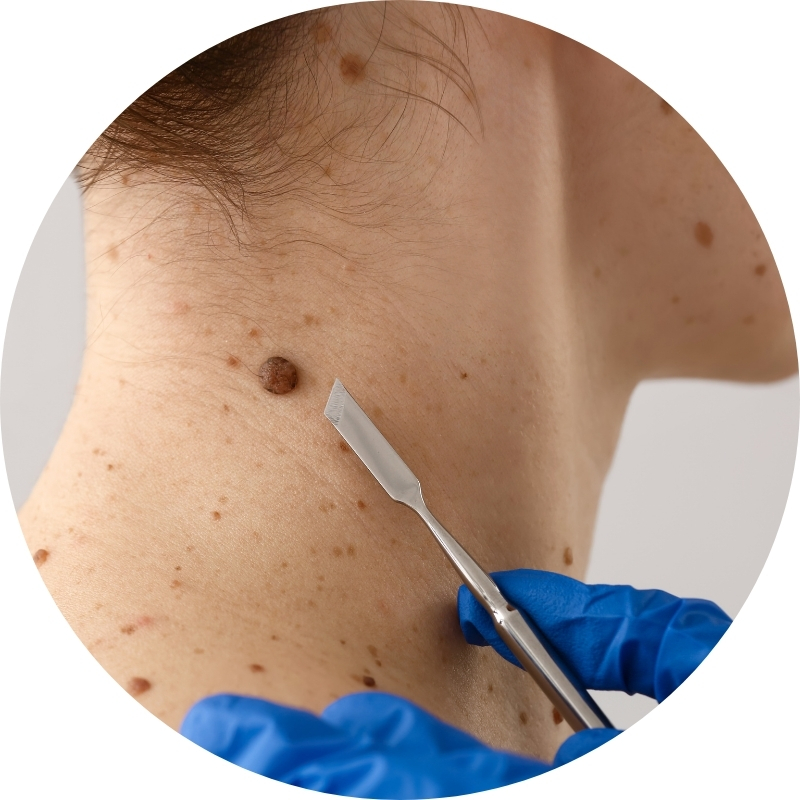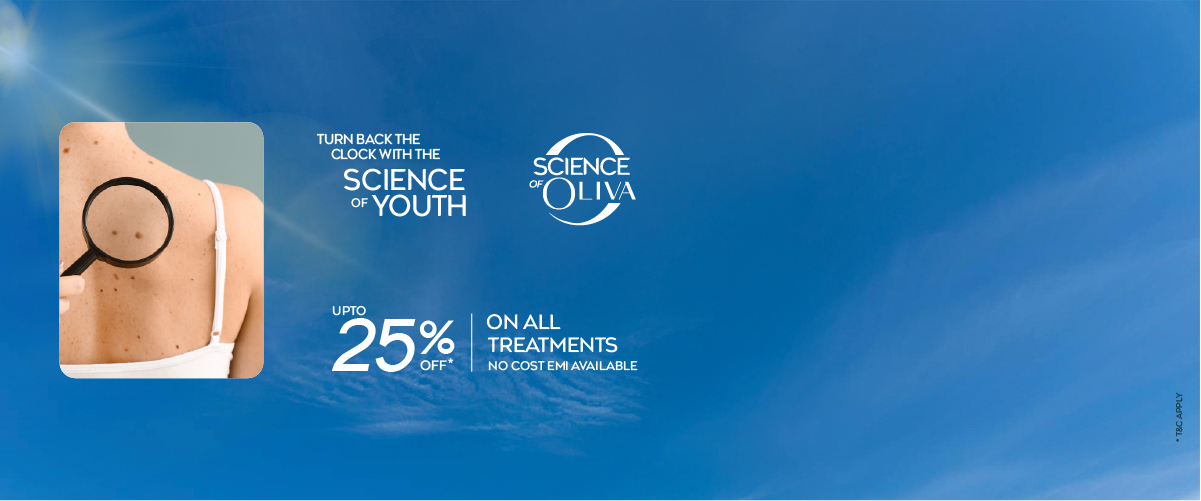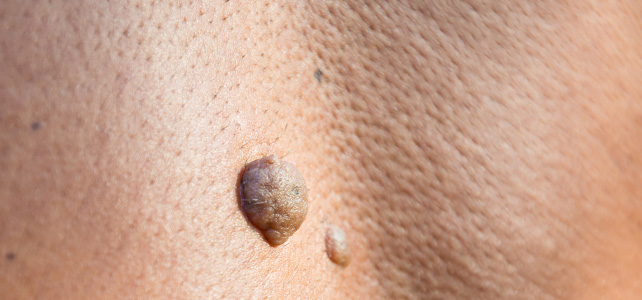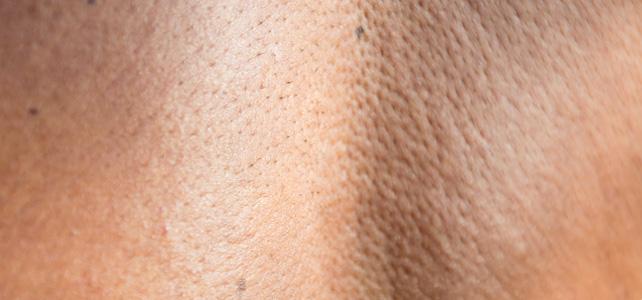Why Choose Oliva Clinic For Mole Removal?
Over 115 experienced MD-certified dermatologists.
V-Discover - A 5-step consultation to understand your skin, hair & body.
US-FDA approved equipment ensuring safety and effectiveness.
Achieve significant improvement in a few sessions.
No hidden costs. We ensure full transparency at every step.
Served 7,50,000+ happy clients with a 95% satisfaction rate.
What Is A Mole?
Moles, medically referred to as nevi, are common skin growths that are usually black or brown in colour. These may appear alone or in bunches, anywhere on the body, and vary in size, colour, and texture. While most moles form during childhood and adolescence, some people continue developing new ones until age 40.
What Are The Causes Of Moles?
Moles primarily occur when melanocytes (a pigment that gives skin its natural colour) grow in clusters. Several other factors may contribute to the development of moles on the body. These include:
- Genetics: Moles can often be a genetically inherited pattern, especially the number and their location.
- Sun Exposure: Exposure to UV rays can trigger mole formation on your skin or cause existing moles to darken. Individuals with fair skin tones, light-coloured eyes, and red or blonde hair are more prone to sun damage, which increases their risk of developing moles.
- Hormonal Changes: Hormonal changes during puberty and pregnancy can lead to the development of new moles or changes in size and colour of existing ones.
- Immune System: People with a weakened immune system may be more prone to abnormal skin growths.
- Age: Moles can form at any stage of life, though they typically begin to appear during childhood or teenage years. Over time, their appearance may change. Some may lighten, darken, or even disappear altogether as a person gets older.
Types Of Moles
Understanding the type of mole helps determine the best mole removal treatment. The most common types include:
- Congenital Moles: These are the moles that are present since birth.
- Acquired Moles: These moles develop after birth and often appear in shades of brown.
- Dysplastic Nevi: These are irregular-shaped moles that are brown in the centre and have a lighter colour on the edges. These are mostly inherited and potentially have the chance of developing into melanoma.
- Spitz Nevi: These are pinkish, dome-shaped moles that typically appear in childhood. They are often confused with melanoma because of their appearance and rapid growth.
- Blue Nevi: This is a benign type of mole that may appear as a blue lump on the skin. These can appear at the time of birth or develop later and are usually harmless.
- Halo Nevi: These are moles surrounded by a white ring, resulting from an immune response. These are benign moles.
- Lentigo: These are flat, pigmented spots with a clearly defined edge, often caused by sun exposure.
- Compound Nevi: These moles are dark brown in colour and are a mix of raised and flat mole features.
How Does Mole Removal Treatment Work?
Oliva’s dermatologists perform one or a combination of these treatments. Find out how they work:
- Radiofrequency or electrocautery removal: Dermatologists use a sharp probe to pass an electric current and shed off the mole without damaging the surrounding tissues.
- Punch excision: After administering local anaesthesia, using a sharp, round knife known as a punch, dermatologists remove the whole lesion. If necessary, they will facilitate wound healing with a stitch.
- Q-switched Nd:YAG Laser: Using this advanced laser technology, dermatologists target flat, pigmented moles in the deeper layers. The laser beam breaks down the pigment deposit that the body’s immune system releases naturally.
Methods Of Mole Removal Treatments At Oliva
At Oliva, we offer science-backed, dermatologist-supervised treatments tailored to different mole types and locations. Accordingly, dermatologists at Oliva perform the following treatments as a standalone or combination for effective mole removal.
- Radiofrequency & Electrosurgery: Dermatologists at Oliva use a device that passes controlled electric currents to burn and remove the mole without damaging the surrounding skin. This treatment is ideal for small or raised moles.
- Punch Excision: This is a precise surgical method to remove deeper or larger moles using a punch tool. Dermatologists administer local anaesthesia before performing the treatment. Punch excision is ideal for removing flat moles and those with irregular borders.
- Laser Mole Removal: The Q-Switched Nd:YAG laser is the most sought-after option for mole removal. Dermatologists at Oliva use this advanced laser technology to remove moles where they target focused laser beams on the targeted areas to break down melanin, which the body’s immune system releases naturally. This treatment reduces pigmentation safely without cuts or stitches.
How Is Mole Removal Procedure Done At Oliva?
Pre-treatment

- This is the first stage of the procedure, which starts with a detailed consultation with our expert dermatologist.
- During the consultation, the doctor will assess your skin, mole type, colour, and size.
- Based on the mole analysis, they will recommend the most suitable mole removal treatment with the number of sessions you may need.
During the treatment

- On the day of the procedure, the therapist will prepare your skin by cleansing it thoroughly to remove any oil, dirt or grime.
- Later, they will apply a local anaesthesia (if needed) and the dermatologist will proceed with the execution of the selected technique (Radiofrequency, punch excision or laser).
- Depending on the size and type of mole, the procedure might last for about 15-45 minutes.
Post-Treatment

- After the procedure, they will apply a soothing cream to minimise any discomfort.
- The dermatologist will provide some post-care instructions, like sun protection, a gentle skincare routine and topical medication.
- They will schedule the next session to follow up and track the healing and results.

Don’t let a mole hold you back. Choose the safest, most effective way to remove it with the experts at Oliva Clinics.
Book NowBefore & After Results
Here are the before-and-after pictures of our clients, who noticed smoother skin and significantly reduced pigmentation within a few weeks. Whether it’s mole removal on the face, neck mole removal, or mole on any area of the body, our trained dermatologists ensure natural-looking results without leaving a scar.
*Images are from real clients, and results can be subjective
How Much Does Mole Removal Treatment Cost In India?
Mole removal treatment cost in India typically ranges from Rs. 3,000 to Rs. 10,000 per session. The price may vary for individuals based on several factors, including the size and location of the mole, the treatment modality, the location and reputation of the clinic, and the doctor’s experience.
Client Reviews
Read below what our esteemed clients have to say about us and what makes us the premier provider of skin and hair care services.
Total Reviews
Average Ratings
Verified client
Verified client
Verified client









